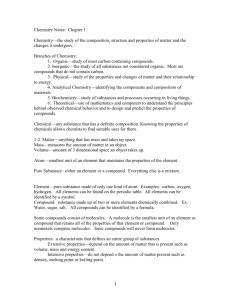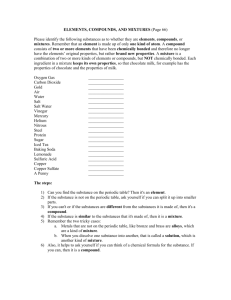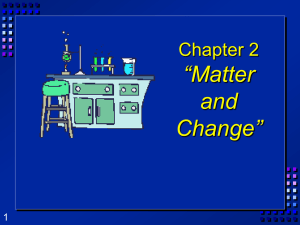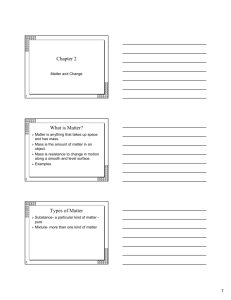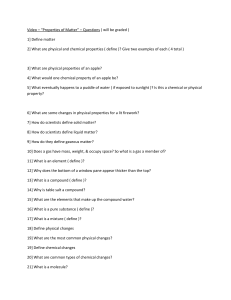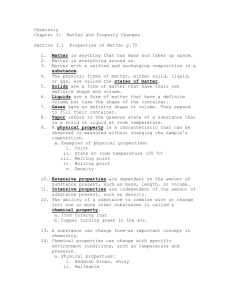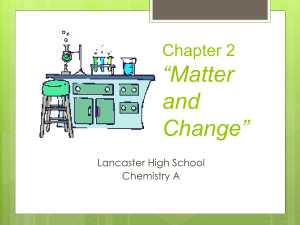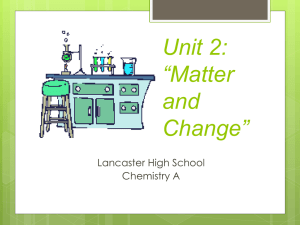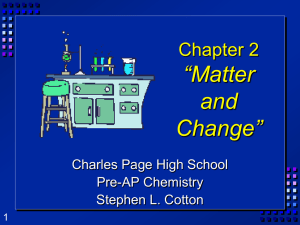Matter and Change
advertisement
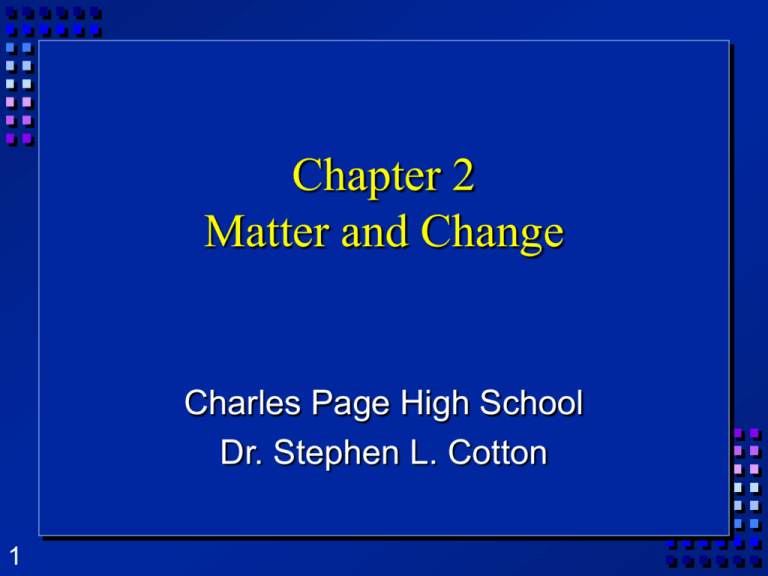
Chapter 2 Matter and Change Charles Page High School Dr. Stephen L. Cotton 1 Section 2.1 Matter OBJECTIVES: –Identify the characteristics of matter and substances. 2 Section 2.1 Matter OBJECTIVES: –Differentiate among the three states of matter. 3 Section 2.1 Matter OBJECTIVES: –Define physical property, and list several common physical properties of substances. 4 What is Matter? Matter is anything that takes up space and has mass. Mass- amount of material or “stuff” in an object Weight is due to gravity, and changes from location to location; mass is always constant. 5 Types of Matter Substance- a particular kind of matter - pure; is uniform (all the same) and has a definite composition (examples are elements & compounds) –water; gold; lemonade? Mixture- more than one kind of matter; has a variable composition 6 Properties Words that describe matter (adjectives) Physical Properties- a property that can be observed and measured without changing the composition. Examples- color, hardness, m.p., b.p. Chemical Properties- a property that can only be observed by changing the composition of the material. 7 States of matter Solid- matter that can not flow (definite shape) and has definite volume. Liquid- definite volume but takes the shape of its container (flows). Gas- a substance without definite volume or shape and can flow. Vapor- a substance that is currently a gas, but normally is a liquid or solid at room temperature. (water vapor?) 8 States of Matter Definite Definite Temp. ComVolume? Shape? increase pressible? Solid Liquid Gas 9 YES YES NO YES Small Expans. NO NO Small Expans. NO NO Large Expans. YES Condense Freeze Evaporate Melt Solid 10 Liquid Gas Physical Changes A change that changes appearances, without changing the composition. Ex. Boil, melt, cut, bend, split, crack Boiled water is still water. Chemical changes - a change where a new form of matter is formed. Ex. Rust, burn, decompose, ferment 11 Section 2.2 Mixtures OBJECTIVES: –Categorize a sample of matter as a substance or a mixture. 12 Section 2.2 Mixtures OBJECTIVES: –Distinguish between homogeneous and heterogeneous samples of matter. 13 Mixtures Physical blend of at least two substances; variable composition Heterogeneous- mixture is not uniform in composition Chocolate chip cookie, gravel, soil. Homogeneous- same composition throughout; called “solutions” Kool-aid, air, salt water Every part keeps it’s own properties. 14 Solutions Homogeneous mixture Mixed molecule by molecule Can occur between any state of matter –Table 2.3, page 33 –gas in gas; liquid in gas; gas in liquid; solid in liquid; solid in solid (alloys), etc. 15 Solutions Like all mixtures, they keep the properties of the components. Some can be separated easily by physical means: rocks and marbles, iron filings and sulfur Other methods: distillation- takes advantage of different boiling points 16 Section 2.3 Elements and Compounds OBJECTIVES: –Explain the differences between an element and a compound. 17 Section 2.3 Elements and Compounds OBJECTIVES: –Identify the chemical symbols of common elements, and name common elements given their symbols. 18 Elements- Substances simplest kind of matter cannot be broken down any simpler all one kind of atom. Compounds are substances that can be broken down only by chemical methods When broken down, the pieces have completely different properties than the original compound. Made of two or more atoms, chemically combined (not physical blend!) 19 Compound or Mixture Compound 20 Mixture Made of one kind of material Made of more than one kind of material Made by a chemical change Made by a physical change Definite composition Variable composition Which is it? Mixture Element Compound 21 Chemical Symbols & Formulas Currently, there are 115 elements Each has a 1 or two letter symbol First letter always capitalized; the second never; chemical “shorthand” Don’t need to memorize all of them; know Table A.3 inside back cover Some from Latin or other languages; note Table 2.4, page 40 22 Section 2.4 Chemical Reactions OBJECTIVES: –Differentiate between physical and chemical changes in matter. 23 Section 2.4 Chemical Reactions OBJECTIVES: –Apply the Law of Conservation of Mass. 24 Chemical Reactions When one or more substances are changed into new substances. Reactants- stuff you start with Products- What you make ability to undergo chemical reaction is called a chemical property products have NEW PROPERTIES Arrow from reactants to products 25 Indications of a chemical reaction: Energy absorbed or released (temperature changes hotter or colder) Color change Gas production (bubbling, fizzing, or odor change) formation of a precipitate- a solid that separates from solution (won’t dissolve) Irreversibility- not easily reversed 26 Law of Conservation of Mass Mass can not be created or destroyed in ordinary (not nuclear) chemical reactions or physical change All the mass can be accounted for. –Burning of wood results in products that appear to have less mass as ash; where is the rest? 27

